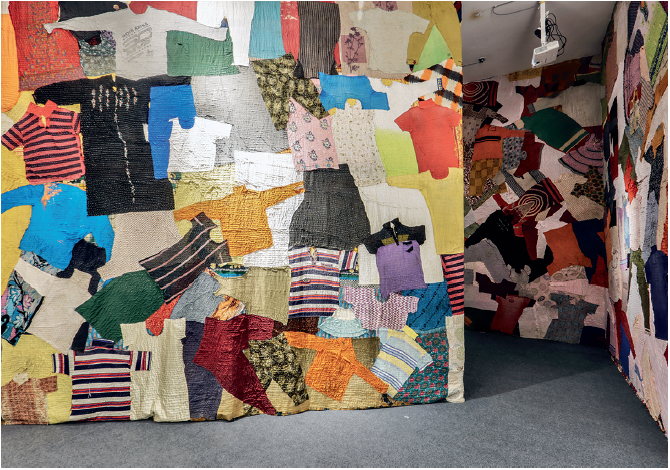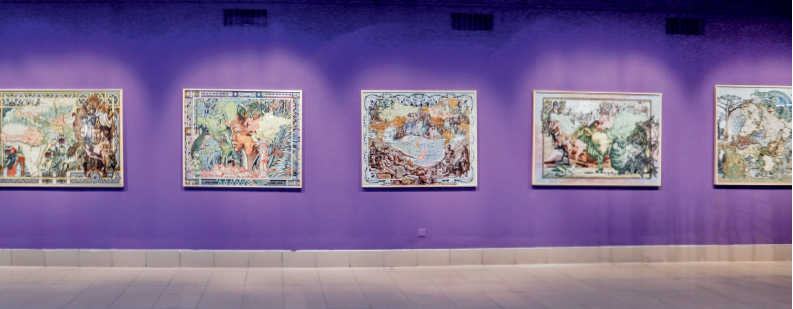Dhaka Art Summit 2018
Although hidden under a staircase at Dhaka’s Shilpakala Academy, Indian artist Sheela Gawda’s largescale gamcha installation resonates powerfully. The colourful cotton towels act as a social equalizer: a local textile used in every house in Bangladesh, regardless of status. Gawda’s work, which recomposes mundane materials to uncover their untold histories, is emblematic of the themes of this year’s Dhaka Art Summit (DAS).
Founded in 2012 by the Samdani Art Foundation, the 2018 iteration of DAS drew over 300,000 local and 800 international visitors over nine days. Free to the public, DAS is the largest non-commercial exhibition of art in South Asia. Expanding its reach beyond Bangladesh, DAS 2018 exhibited artists from all over South and Southeast Asia, its sole aim being to promote art from the region to the rest of the world. Produced by Bangladeshi collector-couple Rajeeb and Nadia Samdani, in collaboration with the country’s Ministry of Cultural Affairs, the private/public exhibition takes place every two years (though it rejects the label of biennial).
DAS is a massive undertaking, in both its physical size and intellectual scope, and encompasses multiple types of exchanges and inquiries, ranging from collaborative group exhibitions to experimental writing initiatives, as well as live performance spaces, large solo projects and a robust program of talks and films. Led by Chief Curator Diana Campbell Betancourt, local and international guest curators from leading global institutions were commissioned to produce shows focusing on issues relating to South Asia, which this year found its frame of reference in the region’s ongoing Rohingya crisis and the issue of human migration, as well as the continuing deleterious effects of colonialism in the region.

Kamruzzaman Shahdin, Haven is Elsewhere, 2017–18, at the “Bearing Point 5” exhibition, curated by Diana Campbell Betancourt. All photos: Noor Photoface.
The overwhelming issue of migration was front and centre in Bangladeshi artist Kamruzzaman Shahdin’s colossal patchwork piece, Haven is Elsewhere. Using the traditional Bengali kantha embroidery technique, the floor-to-ceiling quilt was sewn together by the migrant community in northwest Bangladesh. Consisting of items of clothing worn by migrant workers, the piece brings to life their constant quest for a safe haven in a devastatingly palpable way, using the giant quilt as a screen on which to project videos of stories of displacement. The clothes and stories were collected over a year and a half from illegally trafficked labourers, as well as from Rohingya refugees in Bangladesh. Ultimately, the piece is an elegy for those who cannot escape the cycle of illegal trafficking, for whom haven spirals further and further out of reach.
Shahdin’s piece is part of the summit’s fulcrum curation, Betancourt’s “Bearing Points,” comprised of large-scale works that offer a jumping-off point to explore the transcultural histories undergirding the nine guest-curated exhibitions throughout the building.
Another one of these central pieces is Sri Lankan/Australian artist Ramesh Mario Nithiyendran’s monumental idols of multi-gendered gods of his own devising. Taking their cue from the indigenous clay totems of South Asia, Nithiyendran’s visually stunning and technically skilled 21st-century ‘deities in drag’ create a new mythology of a post-gender world. Breaking free of his traditional identity constraints, Nithiyendran co-opts classical symbols of masculinity and femininity to create new forms of hybridized, transgendered god-like figures. By experimenting with form and scale, his work begins to transcend local boundaries and explores universal politics of sex, the monument, gender and religion.
Bangladeshi artist Munem Wasif also re-examines deities in his piece, Seeds Shall Set Us Free, which finds its roots in regional ecological philosophies of grain deities. His cyanotype prints of rice seeds reference the Bengali tradition of ritual rice-pasta floor paintings, as well as the way traditional Bangladeshi reliance on agriculture has transformed from feeding local needs into feeding global flows of capital, ironically leading to dispossession and hunger. Recalling the 1944 Bengal famine, the work is a meditative critique of the sort of ecological colonialism that introduces plantation farming and crop monocultures to the great detriment of local ecological and human needs.

Installation view, Malala Andrialavidrazana, Figures, 2015–16, at the “A Beast, a God, and a Line” exhibition, curated by Cosmin Costinas.
For over 2,000 years, Bengal was at the crossroads of one of the most cosmopolitan and wealthy regions in the world, a site ripe for the taking. Located at the geographical and cultural border of South and Southeast Asia, Bengal has always been a locus for the fantasies of travel and exotification of the “other” that were the primary engines of colonialism.
This historical context is the starting point of Cosmin Costinas’s curation, “A Beast, a God, and a Line,” in which Madagascar-born artist Malala Andrialavidrazana’s work deftly showcases the interaction between the geography of seafaring and the flow of capital. Her complex collages of 19th-century European maps and fragments of banknotes from different countries reveal the narratives of power that are at the heart of objects so mundane that their use as instruments of control escapes our attention. The colourful compositions uncover the myths that buttress imperial ideologies and reveal a deeper story of conflict and struggle.
Munem Wasif alludes to the devastating effects of this history in his film, Machine Matters. In a slow sweep of the defunct machines of a jute factory in Bangladesh, Wasif conjures the country’s conversion from a fine textile producer to a cheap polyester manufacturer, and recalls the control of the British Raj, whose relentless appetite drove the indigenous cotton subspecies of muslin into extinction.
For centuries Bangladesh was the site of production for the skilful, labour-intensive art of weaving jamdani muslin. One of the finest textiles in the world—patronized by Mughal emperors and recognized as an Intangible Heritage of Humanity by UNESCO—the slow art of its careful weaving suffered heavily under the economic exploitation of the colonial adventure. But this art form is being revived by the Samdani Art Foundation, which has funded the descendants of the jamdani weavers to produce these mystical fabrics, reclaiming the history of Bengal as a powerhouse of cultural production.
Through its Art Award and its new Architecture Award, as well as by commissioning many of the works in the exhibition, the Samdani Art Foundation has made the Dhaka Art Summit a new site for production in the region, a haven for labour and a rejection of a history of exploitation. ❚
The 2018 Dhaka Art Summit was exhibited at the Bangladesh Shilpakala Academy, Dhaka, Bangladesh, from February 2 to February 10, 2018.
Mohammad N Miraly is a published scholar and art collector. He holds a PhD in Religion, Ethics, and Public Policy from McGill University and serves on the Tate Modern Acquisition Committee for South Asia.

